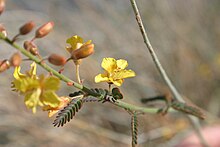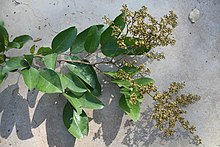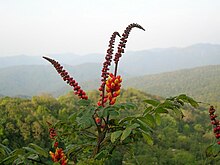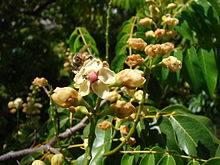Carob family
| Carob family | ||||||||||||
|---|---|---|---|---|---|---|---|---|---|---|---|---|

Peacock shrub ( Caesalpinia pulcherrima ), inflorescence |
||||||||||||
| Systematics | ||||||||||||
|
||||||||||||
| Scientific name | ||||||||||||
| Caesalpinioideae | ||||||||||||
| DC. |
The carob family , known in Austria as the fenugreek family (Caesalpinioideae), is a subfamily of the legume family (Fabaceae). The 2000 to 3000 species have areas mainly in the tropics and subtropics , especially in the Neotropics and Africa . Some species are used as ornamental plants in tropical to subtropical parks and gardens . The wood is used by many species from a few genera .
description
Appearance and leaves
The carob family mainly includes trees and only a few shrubs , lianas or perennial herbaceous plants . They usually grow upright on their own or more rarely as twisting, climbing or climbing plants with shoots or leaf tendrils. They are mesophytes or xerophytes . They can contain resin . The secondary growth in thickness usually occurs from a conventional cambium ring or anomalously from a concentric cambium (for example in Koompassia ).
Carob family are evergreen or deciduous. The alternate and spiral or two-line arranged leaves can be stalked or almost sitting to sitting. The leaf blades are usually single or double pinnate. The herbaceous, membranous or leathery leaflets have pinnate veins. There may be a cushion on the leaflets. Heterophyllia is rare . Stipules are present. In a few species, the leaves are reduced and phyllodes can be formed or parts of the shoot axes take over photosynthesis . The stomata are paracytic or anomocytic, cyclocytic and actinocytic.
The leaves or stipules can be transformed into thorns . The almost always present stipules (here intrapetiolar stipules) are well developed or reduced to scales and can be durable or fall off early.
Inflorescences and flowers
The flowers are solitary or in lateral or terminal, simple or branched, racemose , spiked , zymous or bundled inflorescences . The flowers are mostly hermaphroditic, but there can also be monoecia , andromonoecia or polygamomonoce.
The small to large radial symmetry to more or less zygomorphen flowers are fünfzählig with double or single (at about 26 genera) perianth (perianth). For example, most Detarieae have a free flower cup (hypanthium). The mostly five (three to six) sepals are mostly fused. The five petals are mostly free. The green, white, from yellow to orange to red or from pink to purple-colored petals can be nailed or sessile. Petals may be missing. An ascending, overlapping petal cover (imbricat) can be seen in the flower buds. There are seldom only one, usually up to ten, with Maniltoa there are up to 100 stamens . The same to distinctly unequal stamens can be freely or in different ways fused together, but they are never fused with the petals. The stamens can all be fertile or some are transformed into staminodes . The pollen grains usually have three or less often two or four apertures and are mostly colporat, more rarely porat or colpat. There is only an upper carpel . There can be one to a hundred ovules per carpel .
Fruits and seeds
The fleshy or non-fleshy fruits are mostly legumes , rarely nuts, follicles or drupes. The fruits remain closed when ripe or they open; the diaspores are therefore the fruits or the seeds.
The seeds can contain endosperm and starch. The chlorophyll-containing embyro is usually straight, often curved and has two flat cotyledons ( cotyledons ).
ecology
In contrast to the other Fabaceae, only a few species of the Caesalpinioideae have root nodules with nitrogen-fixing nodule bacteria , and if they are present then often only a few of them.





Systematics
As first publication of Caesalpinioideae applies Augustin Pyramus de Candolle : Prodromus naturalis regni systematis veg , 2, 1825, pp 473 in which he published the name "Caesalpineae". The name of the type genus Caesalpinia honors the Italian botanist Andrea Cesalpino . Synonyms for Caesalpinioideae DC. are: Caesalpiniaceae R.Br. , Cassiaceae Vest , Ceratoniaceae Link , Detariaceae (DC.) Hess .
According to the results of molecular biological studies, the subfamily Caesalpinioideae in its traditional definition is a paraphyletic taxon within the monophyletic family Fabaceae . The tribe Cercideae used to be included, but in the new systematics it is not assigned to any of the three subfamilies, but was recognized as a basic group of the Fabaceae family tree. However, they were often viewed as an independent family Caesalpiniaceae.
According to new investigations, this subfamily is only divided into three tribes and contains 120 to 170 genera with around 2000 to 3000 species:
- Tribus Caesalpinieae : The flowers are radially symmetrical to zygomorphic. The sepals are mostly free. The leaves are usually double-pinnate. It contains up to 51 genera:
-
Acrocarpus Wight ex Arn. : It contains only one type:
- Acrocarpus fraxinifolius Wight ex Arn. : It is native to Asia and is grown in many tropical areas.
- Arapatiella Rizzini & A.Mattos : The only two species occur only in the Brazilian state of Bahia .
-
Arcoa Urb. : It contains only one type:
- Arcoa gonavensis Urb. : It isnativeto Hispaniola .
-
Balsamocarpon Clos : It contains only one type:
- Balsamocarpon brevifolium Clos : It occurs in the Chilean regions III Atacama and IV Coquimbo .
-
Batesia Spruce ex Benth. & Hook. f. : It contains only one type:
- Batesia floribunda Spruce ex Benth. : It occurs in the Brazilian states of Acre and Amazonas , in French Guiana , in southeastern Colombia and in the Peruvian province of Loreto .
-
Burkea hook. : It contains only one type:
- Burkea africana hook. : It iswidespreadin Africa .
- Bussea Harms : Of the approximately seven species, five are distributed in tropical Africa and two in Madagascar .
- Caesalpinia ( Caesalpinia L. ): The approximately 100 species are widespread in the tropics and subtropics.
- Campsiandra Benth. : The 19 or so species are distributed in tropical South America , especially in the Amazon region.
- Cenostigma Tul. : The 14 species are common in Brazil , Central America and the Caribbean.
-
Ceratonia L .: It contains only two species:
- Ceratonia oreothauma Hillc. & al. : It occurs only in the Arabian Peninsula and Somalia .
- Carob tree ( Ceratonia siliqua L. ): It is native to Europe , Asia Minor , the Canary Islands and North Africa.
-
Chidlowia Hoyle : It contains only one species:
- Chidlowia sanguinea Hoyle : It occurs in tropical West Africa .
-
Colvillea Bojer ex Hook. : with the only kind:
- Colvillea racemosa Bojer ex Hook. : It is native to Madagascar.
- Conzattia Rose : The only three species occur only in Mexico .
-
Cordeauxia Hemsl. (Perhaps it belongs to the genus Stuhlmannia Taub. ): It contains only one species:
- Cordeauxia edulis Hemsl. : It occurs only in Ethiopia and southern Somalia .
-
Delonix Raf. : with about twelve species mainly in East Africa , for example:
- Flame tree ( Delonix regia (Bojer ex Hook.) Raf. ): It is only native to northern and western Madagascar. It is used as an ornamental plant in tropical and subtropical areas.
- Dimorphandra Schott : The approximately 26 specieswidespreadin South America .
-
Diptychandra Tul. : It contains only two types:
- Diptychandra aurantiaca Tul. : It occurs in Brazil, Bolivia and Paraguay .
- Erythrophleum Afzel. ex R.Br. : The approximately nine species are common in the Paleotropic .
- Gleditschien ( Gleditsia L. , Syn .: Gleditschia Scop. ): It has a disjoint area and contains about 12 to 14 species.
- Antler trees ( Gymnocladus Lam. ): It has a disjoint area in North America and East Asia and contains about three to six species.
-
Haematoxylum L .: Of the approximately five species, four are found in the Neotropics and one in Namibia , for example:
- Bluewood tree ( Haematoxylum campechianum L. )
-
Heteroflorum M.Sousa (until 2005 it belonged to the genus Peltophorum (Vogel) Benth. ): It contains only one species:
- Heteroflorum sclerocarpum M.Sousa : It occurs in Mexico.
- Hoffmannseggia Cav. : The 24 to 28 species arewidespreadin the New World .
- Jacqueshuberia Ducke : The sixor sospecies occur mainly in the Amazon basin and the range extends to Venezuela .
-
Lemuropisum H.Perrier : It contains only one species: (Syn. From Delonix Raf. )
- Lemuropisum edule H.Perrier : It occurs only in southwestern Madagascar.
-
Lophocarpinia Burkart : it contains only one species:
- Lophocarpinia aculeatifolia (Burkart) Burkart : It occurs in the Argentine provinces of Chaco, Formosa and Salta and in Paraguay .
-
Melanoxylum Schott : It contains only one species:
- Melanoxylum brauna Schott : It occurs in the Brazilian states of Bahia, Minas Gerais and Rio de Janeiro.
- Moldenhawera Schrad. : The ten or so species occur in eastern Brazil, especially in the Atlantic rainforest, mainly in Bahia.
-
Mora Benth. : The seven or so species thrive in the lowland rainforest of the Neotropics.
- Mora excelsa Benth. : In the Guyanas to Venezuela and in Trinidad
-
Moullava Adans. : It contains four types:
- Moullava spicata (Dalzell) Nicolson : It occurs only in India .
-
Orphanodendron Barneby & JWGrimes : It contains only two types:
- Orphanodendron bernalii Barneby & JWGrimes : It is only found in Colombia.
-
Pachyelasma Harms : It contains only one type:
- Pachyelasma tessmannii (Harms) Harms : It occurs in tropical Africa.
- Parkinsonia ( Parkinsonia L. ): The ten or so species are mainly found in the New World.
-
Paubrasilia Gagnon, HCLima & GPLewis : It contains only one species:
- Paubrasilia echinata (Lam.) Gagnon, HCLima & GPLewis : It occurs only in Brazil.
- Peltophorum (Vogel) Benth. : with about twelve species in the tropics and subtropics worldwide.
- Pomaria Cav. (Syn .: Cladotrichium Vogel , Melanosticta DC .; The species were previously placed in the genus Hoffmannseggia Cav. ): Of the approximately 16 species, nine come from arid and mountainous regions of the southwestern United States and neighboring areas in Mexico, and three species from temperate eastern South America and three species in southern Africa.
-
Pterogyne Tul. : It contains only one type:
- Pterogyne nitens Tul. : It is widespread in Brazil, eastern Bolivia, northern Argentina and Paraguay.
- Pterolobium R.Br. ex Wight & Arn. : The ten or so species are widespread mainly on the Asian continent to Indonesia and the Philippines, but also in tropical and subtropical Africa.
- Recordoxylon Ducke : The two to five species are common in the Neotropics.
- Schizolobium Vogel : The roughly two species are common in the Neotropics.
- Stachyothyrsus Harms : The roughly two species are common in tropical Africa.
-
Stahlia Bello : It contains only one species: (Syn. From Libidibia (DC.) Schltdl. )
- Stahlia monosperma (Tul.) Urb. : It occurs only in the Dominican Republic and Puerto Rico .
-
Stenodrepanum Harms : It contains only one species:
- Stenodrepanum bergii Harms : It occurs in Argentina.
-
Stuhlmannia Taub. : It contains only one type:
- Stuhlmannia moavi deaf. : It thrives in the coastal forest of Tanzania .
- Sympetalandra Stapf : The approximately five species occur on the Malay Archipelago : Borneo, Malaysia, the Philippines and the Lesser Sunda Islands .
- Tachigali Aubl. : The approximately 70 species thrive in the lowlands, mainly in northern South America and in the Atlantic rainforest of southern Brazil.
- Tetrapterocarpon Humbert : The only two types occur only in Madagascar.
- Vouacapoua Aubl. : The only three species occur in the Brazilian Amazon and the Guyanas.
-
Zuccagnia Cav. : It contains only one type:
- Zuccagnia punctata Cav. : It occurs in Argentina and northern Chile.
-
Acrocarpus Wight ex Arn. : It contains only one type:
- Tribus Cassieae : The flowers are mostly more or less zygomorphic. The petals are at most sanded out. The leaves are simply pinnate. It contains three subtribes with about 21 genera:
- Subtribus Cassiinae: It contains about three genera with about 665 species:
- Cassia ( Cassia L. , Syn .: Bactyrilobium Willd. , Cathartocarpus Pers. ): Without the species of the separated genera Senna and Chamaecrista, it contains around 30 (previously up to 70) species. It is found almost worldwide in the tropics and four species are grown in many tropical countries.
- Chamaecrista Moench (Syn .: Grimaldia Cabinet , Sooja Siebold , Cassia subgen. Lasiorhegma Vogel ex Benth. , Cassia subgen. Absus (DC. Ex Collad.) Symon ): The approximately 330 herbaceous species are common in the Paläotropis.
- Senna Mill. (Syn .: Cassia subgen. Senna (Mill.) Benth. , Chamaefistula (DC.) G.Don , Chamaesenna (DC.) Raf. Ex Pittier , Desmodiocassia Britton & Rose , Earleocassia Britton , Echinocassia Britton & Rose , Gaumerocassia Britton , Herpetica (DC.) Raf. , Leonocassia Britton , Palmerocassia Britton , Phragmocassia Britton & Rose , Pseudocassia Britton & Rose , Pterocassia Britton & Rose , Sciacassia Britton , Sericeocassia Britton , Tharpia Britton & Rose , Vogelocassia Rose . Britton , X Britton ): Of the approximately 300 species, 206 are distributed in the New World, up to 20 are found in Africa, 33 species are native to Australia, there are nine species in Madagascar and some species are found in Asia and Malesia. Three to five species, the origin of which is uncertain, are widely cultivated.
- Subtribus Dialiinae: It contains about 17 genera with about 74 species:
-
Androcalymma Dwyer : It contains only one species:
- Androcalymma glabrifolium Dwyer : It occurs in Brazil.
- Apuleia Mart. : The two to three types are common in South America.
- Baudouinia Baill. : The six or so species occur only in Madagascar.
- Dialium L .: The 35 to 41 species are distributed in the tropics, with a focus on biodiversity in tropical Africa.
-
Dicorynia Benth. : The approximately two types are common in South America.
- Dicorynia guianensis Amshoff : Suriname, French Guiana and Guyana
-
Distemonanthus Benth. : It contains only one type:
- Distemonanthus benthamianus Baill. : It occurs in tropical Africa.
-
Eligmocarpus Capuron : it contains only one species:
- Eligmocarpus cynometroides Capuron : It occurs in Madagascar.
-
Kalappia Kosterm. : It contains only one type:
- Kalappia celebica Kosterm. : This endangered species is endemic to Malili, which is part of Sulawesi .
- Koompassia Maingay ex Benth. : The two to three types are common in Southeast Asia.
- Labichea Gaudich. ex DC. : The approximately 14 species occur only in Australian, mainly in Western Australia , some species also in Queensland and Northern Territory .
- Martiodendron Gleason : The approximately five species are distributed in South America, three of them in the Amazon basin and one in the caatinga of northeastern Brazil and a species described in 2002 thrives in the Atlantic coastal rainforest of southeastern Brazil.
-
Mendoravia Capuron : It contains only one species:
- Mendoravia dumaziana Capuron : It occurs in Madagascar.
- Petalostylis R.Br. : There are about two species in Australia .
-
Poeppigia C. Presl : It contains only one species:
- Poeppigia procera C. Presl : It is widespread from southern Mexico across Central America and Cuba to Colombia, Brazil, Bolivia and Peru.
- Storckiella Seem. : Of the only two species, one occurs in Australia and one in Fiji .
-
Uittienia Steenis : It contains only one species:
- Uittienia modesta Steenis : It occurs in the Malay archipelago.
-
Zenia Chun : It contains only one species:
- Zenia insignis Chun : It occurs in China and Vietnam .
- Subtribus Duparquetiinae: It contains only one monotypic genus:
-
Duparquetia Baill. : It contains only one type:
- Duparquetia orchidacea Baill. : It occurs in tropical Africa.
-
Androcalymma Dwyer : It contains only one species:
- Subtribus Cassiinae: It contains about three genera with about 665 species:
- Tribus Detarieae DC. : It contains about 83 genera with 735 to 771 species (for the genera see there).
family tree
| Finial family (Polygalaceae) | |||||||||||||||||||||||||||||
| Surianaceae | |||||||||||||||||||||||||||||
| Fabales | |||||||||||||||||||||||||||||
| Quillajaceae | |||||||||||||||||||||||||||||
| Tribe Cercideae | |||||||||||||||||||||||||||||
| Legumes (Fabaceae) | |||||||||||||||||||||||||||||
| Carob family (Caesalpinioideae) | |||||||||||||||||||||||||||||
| Mimosa family (Mimosoideae) | |||||||||||||||||||||||||||||
| Butterflies (Faboideae) | |||||||||||||||||||||||||||||
swell
- The subfamily on the AP website. (Section systematics and description)
- The subfamily at DELTA. (Section description)
- Anne Bruneau, Félix Forest, Patrick S. Herendeen, Bente B. Klitgaard Gwilym P. Lewis: Phylogenetic relationships in the Caesalpinioideae (Leguminosae) as inferred from chloroplast trnL intron sequences. In: Systematic Botany. Volume 26, No. 3, 2001, pp. 487-514, doi: 10.1043 / 0363-6445-26.3.487 .
- Manuel de la Estrella, Francisco J. Cabezas, Carlos Aedo, Mauricio Velayos: Checklist of the Caesalpinioideae (Leguminosae) of Equatorial Guinea (Annobón, Bioko and Río Muni). In: Botanical Journal of the Linnean Society. Volume 151, No. 4, 2006, pp. 541-562, doi: 10.1111 / j.1095-8339.2006.00538.x , (PDF file; 254 kB).
- Enter taxon in search mask for Legumes of the World at Royal Botanical Gardens Kew, 2013 (Systematics section)
Individual evidence
- ^ Augustine Pyramus de Candolle: Prodromus systematis naturalis regni vegetabilis. Volume 2, Treuttel & Würtz, Paris 1825, p. 473 scanned in (PDF file; 338 kB). ( Memento of the original from March 31, 2014 in the Internet Archive ) Info: The archive link was inserted automatically and has not yet been checked. Please check the original and archive link according to the instructions and then remove this notice.
- ↑ Caesalpinioideae in the Germplasm Resources Information Network (GRIN), USDA , ARS , National Genetic Resources Program. National Germplasm Resources Laboratory, Beltsville, Maryland.
- ↑ Mario Sousa S .: Heteroflorum: Un nuevo género del grupo Peltophorum (Leguminosae: Caelaspinoideae: Caesalpinieae), endémico para México , Novon, volume 15, 2005, pp. 213-218.
- ↑ Beryl Simpson, Leah Larkin, Andrea Weeks, Joshua McDill: Phylogeny and Biogeography of Pomaria (Caesalpinioideae: Leguminosae). In: Systematic Botany. Volume 31, No. 4, 2006, pp. 792-804, doi: 10.1600 / 036364406779695915 .
- ↑ Kalappia celebica in the endangered Red List species the IUCN 2011. Posted by: World Conservation Monitoring Center, 1997. Accessed on 10/21/2011.
- ↑ Julio Antonio Lombardi: Martiodendron fluminense (Leguminosae, Caesalpinioideae), a new species from the Atlantic coast rainforest of Brazil. In: Brittonia. Vol. 54, No. 4, 2002, pp. 327-330, doi : 10.1663 / 0007-196X (2003) 54 [327: MFLCAN] 2.0.CO; 2 .












